You are here
Antijudaism, the Catholic Church and the Holocaust – research material
Primary tabs
| Size | Seeds | Peers | Completed |
|---|---|---|---|
| 51.34 MiB | 0 | 0 | 2 |
Antijudaism, the Catholic Church and the Holocaust – research material
In part repackaged books existing on this tracker, but with a lot of new additions.
David I. Kertzer, 2001
The Popes Against The Jews
The Vatican's role in the rise of modern anti-Semitism

In this meticulously researched, unflinching, and reasoned study, National Book Award finalist David I. Kertzer presents shocking revelations about the role played by the Vatican in the development of modern anti-Semitism. Working in long-sealed Vatican archives, Kertzer unearths startling evidence to undermine the Church's argument that it played no direct role in the spread of modern anti-Semitism. In doing so, he challenges the Vatican's recent official statement on the subject, "We Remember.” Kertzer tells an unsettling story that has stirred up controversy around the world and sheds a much-needed light on the past.
A groundbreaking historical study based on documents previously locked in the Vatican’s secret archives: The Popes Against the Jews graphically shows how the Catholic Church helped make the Holocaust possible.
Pope John Paul II, as part of his effort to improve Catholic-Jewish relations, has himself called for a clear-eyed historical investigation into any possible link be-tween the Church and the Holocaust. An important sign of his commitment was the recent decision to allow the distinguished historian David I. Kertzer, a specialist in Italian history, to be one of the first scholars given access to long-sealed Vatican archives.
The result is a book filled with shocking revelations. It traces the Vatican’s role in the development of modern anti-Semitism from the nineteenth century up to the outbreak of the Second World War. Kertzer shows why all the recent attention given to Pope Pius XII’s failure to publicly protest the slaughter of Europe’s Jews in the war misses a far more important point. What made the Holocaust possible was groundwork laid over a period of decades. In this campaign of demonization of the Jews—identifying them as traitors to their countries, enemies of all that was good, relentlessly pursuing world domination—the Vatican itself played a key role, as is shown here for the first time.
Despite its focus, this is not an anti-Catholic book. It seeks a balanced judgment and an understanding of the historical forces that led the Church along the path it took.
Inevitably controversial, written with devastating clarity and dispassionate authority, The Popes Against the Jews is a book of the greatest importance.
"David Kertzer's provocative new book challenges the widely accepted distinction between Catholic anti-Judaism and modern anti-Semitism. He moves beyond recent attacks on the Vatican's record during WWII, indicting not just Pius XII but the entire tradition out of which he emerged. Many will disagree with Kertzer's conclusions, but no one will be able to ignore this disturbing history of the Papacy and the Jews in the modern era." – Brian Porter, Associate Professor of History at the University of Michigan and author of When Nationalism Began to Hate
"This is a powerful and incisive analysis of the ways in which the Vatican and the Catholic Church helped to nurture and shape the emergence of modern anti-Semitic movements that made the Holocaust possible. With the help of solid documentation and clear exposition, Kertzer sweeps away the apologetic myths that have sought to disculpate the church from direct complicity in the tragic fate of European Jewry."
– Professor Robert S. Wistrich, Hebrew University of Jerusalem, author of Hitler and the Holocaust
Gabriel Wilensky, 2010
Six Million Crucifixions
How Christian Teachings About Jews Paved the Road to the Holocaust
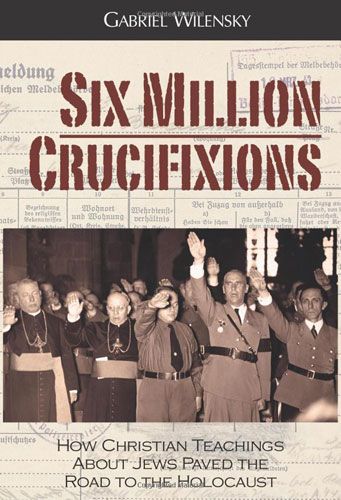
"Six Million Crucifixions: How Christian Antisemitism Paved the Road to the Holocaust" examines the root causes of antisemitism in Christianity and how that prepared the soil for the modern/racial antisemitism that culminated in the Holocaust. The book briefly covers the last two thousand years of history, from the origins of antisemitism all the way to the advent of modern antisemitism. The book also covers the role of the Churches during the Third Reich, and the role of the Vatican in setting up escape routes for wanted war criminals after WWII. At the end the book makes the point that back in 1945-6 the Allies should have set up a third international trial and put any and all clergymen who may have had a role in the defamation of and incitement against the Jewish people, as well as those who helped wanted Nazis escape Justice (and a number of other charges), on the dock.
Purpose of this Book
This book is meant to be used as a resource for increasing the understanding of the root causes of antisemitism that led to the extermination of millions of European Jews in the Second World War. I followed the following objectives in writing this book:
1. To perform historical research to provide a complete understanding of the oral and written teachings that created, promoted and/or encouraged the negative perception of the Jewish people over the last two millennia that culminated in the genocidal antisemitism that engulfed Germany and other European nations during the Second World War;
2. To gather evidence that might make possible the identification of members of the Christian churches who through their acts of commission or omission may have had a role in the extermination of the Jews; to determine the extent and nature of said role; and to suggest what the appropriate legal actions against those responsible would have been;
3. To recommend changes to Christian traditions, doctrine, liturgy and lectionaries to prevent further grave acts of incitement, demonization and segregation caused by the supersessionistic, vicious and defamatory anti-Jewish polemic included in some of those Christian teachings.
What This Book Comprises
Six Million Crucifixions is composed of five parts. The first provides an overview of the historical background of key events spanning the time between the death of Jesus up to the end of the Second World War. By necessity this section is short and can thus only focus on a few relevant events out of the immense amount of material in the almost two thousand year old history. The second part focuses on various specific aspects of Christian Antisemitism. Part III goes into some detail into the role of the Catholic and Protestant Churches during the Nazi era and its aftermath. The fourth part provides an overview of the criminal activities that individual clergy as well as the Churches as such may be guilty of and provides some remedial recommendations. Lastly, the Epilogue gives an account of developments since the conclusion of the war until present time.
Defining Antisemitism
According to the current edition of Merriam-Webster’s dictionary, which continues to use an 1882 definition, antisemitism is “hostility toward or discrimination against Jews as a religious, ethnic, or racial group.” As will be described below, antisemitism took two main forms over the last two millennia, shifting from a theologically based enmity against Jews to a secular and racial hatred.
[...]
A Personal Note
I have been fascinated and amazed by the magnitude and significance of World War II and the Holocaust since I was a teenager. When reading about the Holocaust I was baffled, as I was unable to comprehend how one people could hate another people so much, and in such scale, as the Germans and other European peoples hated the Jews. Think about it: how can you have so much hate in you that every day you get up, you drag thousands of men, women and children to a forest, and shoot them in the head at close range one by one, getting blood, pieces of brain and splinters of cranial bone splattered all over you after each victim, and continue to do it all day long, day after day? Less than half of one percent of Germany’s population before the war was Jewish, so a large majority of the perpetrators probably never even saw a Jew until they invaded Poland! Despite all the books I read over the years, I still could not fathom what it was that motivated that level of hatred. There had to be something else besides relentless racial propaganda. When I finally understood, it motivated me to want to help others understand as well.
Antisemitism is on the rise again. Never since the end of the Second World War have there been so many antisemitic incidents worldwide. The world suffers from amnesia and often disregards the lessons from the past. Film director Mel Gibson releases The Passion of the Christ, a passion play watched by more people than all the previous passion play productions put together, and equally if not more damning of the Jewish people. A senior Vatican cardinal compares the Gaza Strip with a big concentration camp. A Swedish newspaper updates the old Christian Ritual Murder canard and accuses the Israeli Defense Forces—as a proxy for “The Jew”—of killing young Palestinians to harvest their organs. Holocaust denial has become more common, and no amount of lawsuits and debunking seem to make it disappear. Even a shunned, excommunicated Catholic bishop openly denied the Holocaust ever happened, and he was rewarded by Pope Benedict XVI by bringing him back into the Catholic fold. A pope who believes Pope Pius XII “spared no effort in intervening in their [the Jews’] favour either directly or through instructions given to other individuals or to institutions of the Catholic Church” during the war. And this is the same Pope who seems to be interested in eroding the progress made by the Second Vatican Council and reverting to a more traditional version of Catholicism, a version that taught for almost two millennia that Jews were Christ-killers and the enemies of Christianity.
Six Million Crucifixions examines the root causes of antisemitism in Christianity and how that prepared the soil for the modern/racial antisemitism that culminated in the Holocaust. The point of the book is to present the historical background to explain how the Holocaust could have happened, and to raise awareness of where antisemitism comes from and why it has not yet disappeared. In doing so, and despite my best efforts to be true to the historical record, I will surely outrage some readers who will be unable or unwilling to accept anything negative about their Church or religion. Some readers will surely want to dismiss the book outright without even seeing whether they might agree with the points I’m making. The only thing I ask is that they resist this urge and give the book a chance, to read on with an open mind and determine by themselves if they agree or not with my points. I believe that in so doing those readers might learn something, and we might learn something from them.
Robert Michael, 2006
Holy Hatred: Christianity, Antisemitism, and the Holocaust
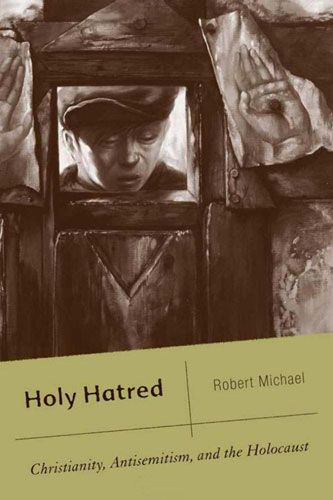
Although Christianity's precise influence on the Holocaust cannot be determined and the Christian churches did not themselves perpetrate the Final Solution, Robert Michael argues in Holy Hatred that the two millennia of Christian ideas and prejudices and their impact on Christians' behavior appear to be the major basis of antisemitism and of the apex of antisemitism, the Holocaust.
Review
"A praiseworthy achievement – a model of its kind." – Paul R. Bartrop, Honorary Research Fellow, The Faculty of Arts, Deakin University, and Head of History, Bialik College
"Holy Hatred is a masterful, beautifully written study of how Christianity and the churches shaped and sustained a lethal antisemitism for almost two millennia. Future studies of the Holocaust or of antisemitism will have to address Michael's work." – Eunice G. Pollack, University of North Texas
"Following in the footsteps of Poliakov and Flannery, this book offers a powerful description of Christianity's intimate involvement with Judeophobia and anti-Semitism from the gospels forward." – Peter J. Haas, Abba Hillel Silver Professor of Jewish Studies, Chair, Department of Religious Studies, and Director, The Samuel Rosenthal Center for Judaic Studies, Case Western Reserve University
"If anyone still remains ignorant of the Christian origins of anti-Semitism – ancient and modern – and its contribution to the Holocaust, this book will remedy that bliss: clearly, and in comprehensive detail." – Richard Elliott Sherwin, Professor, Bar-Ilan University
Marvin Perry and Frederick Schweitzer, 2002
Antisemitism: Myth and Hate from Antiquity to the Present
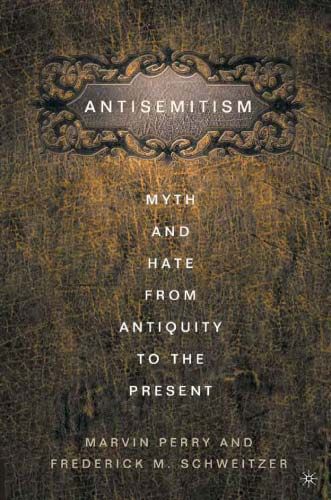
In this provocative book, Marvin Perry and Frederick M. Schweitzer analyze the lies, misperceptions, and myths about Jews and Judaism that antisemites have propagated throughout the centuries. Beginning with antiquity, and continuing into the present day, the authors explore the irrational fabrications that have led to numerous acts of violence and hatred against Jews. The book examines ancient and medieval myths central to the history of antisemitism: Jews as 'Christ-killers', instruments of Satan, and ritual murderers of Christian children. It also explores the scapegoating of Jews in the modern world as conspirators bent on world domination; extortionists who manufactured the Holocaust as a hoax designed to gain reparation payments from Germany; and the leaders of the slave trade that put Africa in chains. No other book has focused its attention exclusively on a thematic discussion of historic and contemporary antisemitic myths, covering such an expansive scope of time, and allowing for such a painstaking level of exemplification.
Robert Michael, 2008
A History of Catholic Antisemitism: The Dark Side of the Church

In recent years, the Catholic Church has come under censure for its inaction during the Holocaust and for its similar passivity in the face of contemporary antisemitism. However, as Robert Michael shows in this comprehensive study, the Church’s involvement in the history of antisemitism goes back to its founding and to the essence of the Christian Scriptures. Moving from the Church’s origins, through the Roman era, Middle Ages, and Reformation to the present, Michael here provides a definitive history of Catholic antisemitism.
Steven Beller, 2007
Antisemitism: A Very Short Introduction

Anti-Semitism has been a chillingly persistent presence throughout the last millennium, culminating in modern times in the horror of the Final Solution. This Very Short Introduction examines and untangles the various strands of anti-Semitism seen throughout history, revealing why hatred of the Jews appears to be so persistent through time. Steven Beller illuminates the history of the phenomenon: from medieval religious conflict, to the growth of anti-Semitism as a political and ideological movement in the 19th century, to the "new" anti-Semitism of the 21st century, as reflected in Holocaust denial and Islamic anti-Zionism. The author also discusses the role and attitudes of key figures such as Wagner, Nietzsche, and Marx, as well as key texts such as the forged "Protocols of the Elders of Zion." In short, this compact book offers an insightful account that underscores how anti-Semitism reached it its dark apogee in the worst genocide in modern history – the Holocaust – and how it still persists around the world today.
Edited by: Kevin P. Spicer, 2007
Antisemitism, Christian Ambivalence, and the Holocaust

In recent years, the mask of tolerant, secular, multicultural Europe has been shattered by new forms of antisemitic crime. Though many of the perpetrators do not profess Christianity, antisemitism has flourished in Christian Europe. In this book, thirteen scholars of European history, Jewish studies, and Christian theology examine antisemitism's insidious role in Europe's intellectual and political life. The essays reveal that annihilative antisemitic thought was not limited to Germany, but could be found in the theology and liturgical practice of most of Europe's Christian churches. They dismantle the claim of a distinction between Christian anti-Judaism and neo-pagan antisemitism and show that, at the heart of Christianity, hatred for Jews overwhelmingly formed the milieu of 20th-century Europe.
The twelve essays comprising this volume originated with a two-week workshop sponsored by the Center for Advanced Historical Studies at the United States Holocaust Memorial Museum in Washington DC. One of the book's chief aims, according to editor Kevin P. Spicer, is to challenge the "strict but misleading separation between Nazi 'racial antisemitism' and 'Christian antisemitism'" (p. ix). The contributors specifically address the role of antisemitism in the Christian response to Nazism, chronicling multiple points of overlap between Christian and Nazi antisemitism. The volume's weakness is that it contains a wide range of cross-disciplinary essays not overtly connected to each other. At the same time, the book's range and scope give it two great strengths: first, it includes work by historians and theologians, thereby representing both disciplinary perspectives; and second, it represents a wide range of Christian perspectives, and includes valuable analyses of Jewish views of Christian antisemitism.
Organized into four parts, the book's first section addresses theological antisemitism. Essays by Thorstein Wagner, Anna Lysiak, Robert A. Krieg, and Donald Dietrich touch on a variety of expressions of antisemitism by priests, theologians, and other prominent religious figures in Denmark, Poland, Germany, and France. Ultimately, these authors show, Christian theology informed Nazi antisemitism in myriad ways that blended with national sentiment, and those bold Christian thinkers who sought to use their theology to resist Nazi anti-Jewishness found themselves bereft of the doctrinal tools to do so. Indeed, as Wagner's essay on the Danish Lutheran Church and the Jews shows, even Denmark's Lutheran clergy, who played a key role in the remarkable rescue of thousands of Danish Jews to Sweden in October 1943, were not free of antisemitism. Challenging the "narrative of heroic humanism" that has emerged as a result of the rescue, Wagner finds that Danish assistance to Jews was less rooted in a belief in religious pluralism and a regard for Jews than in a Danish nationalism constructed in opposition to Nazism and Nazi antisemitism. Further east, Christian thinkers in Poland and Germany deliberately misinterpreted Jewish texts, held fast to supersessionism (the idea that Christians replaced Jews in God's plan for salvation), maintained precritical interpretations of the Bible, and rejected the concept of religious freedom – positions that enabled the rapid spread of Nazi antisemitism. Even those who did think progressively about Christian-Jewish relations during the Nazi era, Dietrich shows, would not see their ideas come into wider acceptance until the Second Vatican Council. [...]
"… a wellpacked collection of twelve articles on the ambivalence of the Christian Church toward the Holocaust and antisemitism." – John Jovan Markovic, Andrews University, Journal Church and State, Vol 50, 3 Summer 2008
"… sheds light on and offers steps to overcome the locked-in conflict between Jews and Christians along the antisemitic path from Calvary to Auschwitz and beyond." – Zev Garber, Los Angeles Valley College and American Jewish University, SHOFAR, Vol. 27, No. 1 Fall 2008
Richard S. Levy, 2005
Antisemitism – A historical encyclopedia of prejudice and persecution
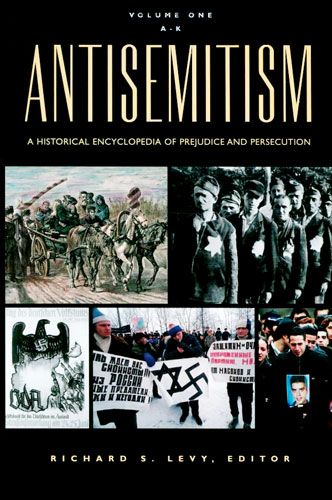
Several years ago, British television featured a program on the history of anti-Jewish prejudice, aptly entitled The Longest Hatred. Although the history of antisemitism is indeed long and the literature voluminous, there are surprisingly few reference works providing an overview.
Containing 612 articles authored by more than 200 scholars and others from 21 countries, this encyclopedia includes alphabetically arranged entries ranging from a few paragraphs to several pages in length. Major historical eras are covered, and the subject range is remarkably eclectic: Armed forces of the United States; General Orders No. 11 (expelling Jews from Tennessee during the Civil War); Hollywood, treatment of antisemitism in; Iconography, Christian; Japan; New Left; and Physics, "German" and "Jewish" are a few examples of entry headings. Many entries provide succinct information on individuals, movements, literary works, and incidents that would require much research time to track down. Coverage is international, with entries for a number of countries, and the chronological reach extends from the treatment of Jews within the Roman Empire to developments in the twenty-first century. When choosing people to be included, the editor used a standard of "significant antisemitic and anti-Jewish thought" to keep the encyclopedia from being "a crude who is/who is not exercise." Along with entries for such individuals as Henry Ford, Adolph Hitler, and Ezra Pound, there are discussions of the history of antisemitism as reflected in the works of T. S. Eliot, Carl Jung, and Mark Twain, among others.
Each entry includes a short bibliography and useful cross-references; a superb index provides easy access to the text. An introductory essay contains a lucid discussion on the elusive definitions of anti-Jewish hatred, commonly known as anti-Semitism (the editor spells the word as antisemitism because there is no such phenomenon as Semitism). In addition, the editor offers very informative historiographical information about the use of the term in various reference and historical works.
This work deserves special praise for providing scrupulously objective information without moralizing about this very painful topic. The text is enhanced with black-and-white photographs and illustrations. Edited by an academic authority who has both contributed several essays and translated some entries from German, this outstanding resource is an essential reference source for general readers, students, and scholars. Highly recommended.
William I. Brustein, 2003
Roots of Hate – Anti-Semitism in Europe before the Holocaust
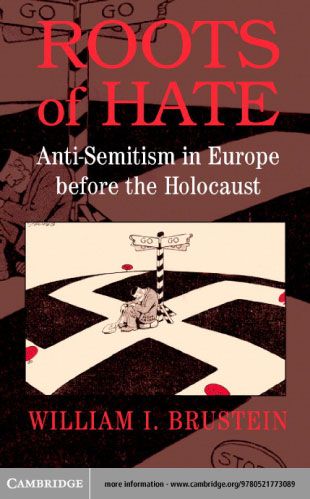
William I. Brustein provides a systematic comparative and empirical examination of anti-Semitism in Europe before the Holocaust. Brustein studies the evolution of the four principal roots of anti-Semitism – religious, racial, economic, and political – and demonstrates how these roots became ignited in the decades before the Holocaust. The book explains the epidemic rise of modern anti-Semitism, societal differences in anti-Semitism, and how anti-Semitism varies from other forms of prejudice. The book draws upon an extensive body of data from Europe's leading newspapers and the American Jewish Year Book.
Michael Berkowitz, 2007
The Crime of My Very Existence - Nazism and the Myth of Jewish Criminality

The Crime of My Very Existence investigates a rarely considered yet critical dimension of anti-Semitism that was instrumental in the conception and perpetration of the Holocaust: the association of Jews with criminality. Drawing from a rich body of documentary evidence, including memoirs and little-studied photographs, Michael Berkowitz traces the myths and realities pertinent to the discourse on "Jewish criminality" from the eighteenth century through the Weimar Republic, into the complex Nazi assault on the Jews, and extending into postwar Europe.
Stephen Eric Bronner, 2000
A Rumor About the Jews: Reflections on Antisemitism and The Protocols of the Learned Elders of Zion
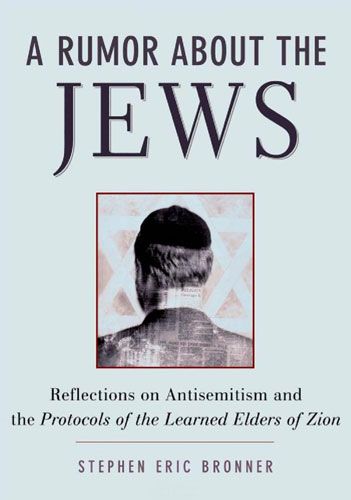
In its portrayal of Judaism as a worldwide conspiracy dedicated to the destruction of Christian civilization, the Protocols of the Learned Elders of Zion remains one of the most infamous documents ever written. Despite being proven a crude forgery, the pamphlet managed to pervade twentieth-century thinking, often being twisted to suit its handlers' purposes, and to justify the most extreme persecution of the Jews. As recently as 2002, a documentary was aired in Egypt falsely presenting the Protocols as fact – and the Protocols is still regarded as a historical document in many other parts of the world.
In A Rumor About the Jews, Stephen Eric Bronner systematically debunks the antisemitic assertions made in the Protocols. He also explores its history, its influence on right-wing movements throughout the twentieth century, and the ongoing appeal of bigotry. A work of intellectual history, A Rumor About the Jews takes the reader on a historical journey that provides a new and deeper understanding of an insidious ideology and its broader implications.
Bronner's sharp and penetrating analysis offers new insights into the nature of antisemitism, along with a warning against underestimating the power of this hateful tract.
Recommended for Judaica and intellectual history collections.
Michael Phayer, 2000
The Catholic Church and the Holocaust, 1930-1965

Throwing the spotlight relentlessly on Pius XII ("Hitler's Pope" ) has skewed the question surrounding Catholicism and the Holocaust, depriving us of a record of what the entire church did or did not do. Such a record is provided for the first time in the Michael Phayer's compelling book. Phayer shows that without effective church leadership under Pius XII, Catholics acted ambiguously during the Holocaust – some saving Jews, others helping Hitler murder them, the majority simply standing by. After the Holocaust, with Pope John XXIII at the helm, the church moved swiftly to rid itself of centuries-long antisemitic tradition.
"Very valuable . . . a fine and judicious book . . ." – Istvn Dek, New York Review of Books
"A well-reasoned but damning overview of the Vatican's response to Nazi atrocities during and after WWII. . . . A fair and even-tempered account of a volatile subject." – Kirkus Reviews
"Phayer makes an important addition to the literature of Holocaust studies: he provides evidence that Pope Pius XII . . . knew in early 1942 what was happening to Europe's Jews . . . yet he remained silent. . . . " – Publishers Weekly
Eric Zuesse, 2000
WHY the Holocaust happened – Its religious cause & scholarly cover-up
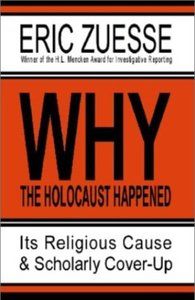
This is Eric Zuesse's mindblowing book WHY the Holocaust Happened - Its Religious Cause and Scholarly Cover-Up (2000) which documents the astounding thesis that the influence of Catholic church and Christian religion inspired the Nazis and actually caused the Holocaust in World war 2.
The Bible is history told as religion tells it. WHY the Holocaust Happened is history told as science tells it. No longer is the challenge to the religious account just Copernicus and Galileo – the Bible got the cosmology wrong. No longer is the challenge to the religious account of Darwin and Mendel – the Bible got the prehistory (i.e., evolution) wrong. Now it is history itself that is at stake; the final fig leaf covering the old myth is ripped away; and what stands exposed this time is rape. People's minds have been raped by a false historical account; and now we know why it lied, and that the Holocaust was the result.
There is not much new to say about Hitler, right? Wrong. By carefully studying Hitler's early writings – something no one else apparently has done – Zuesse arrives at a completely new and profound view of the Nazi period and the holocaust. This is the first work ever to examine the thousands of pages of Adolf Hitler's personal notes, letters, and statements to intimates and supporters, in order to answer the question: Did Hitler himself explain, to himself and to those in whom he confided, why he was so obsessed to exterminate "the Jews"? It turns out that he did but did not intend that the general public – especially not his enemies – know his reason. He explained it only in private notes and letters, and in communications with those he considered "my people," never to oponents or to potential opponents. And he certainly did not want his victims – those he was planning to exterminate – to know the reason for their fate. He furthermore was cunningly expert at controlling the understanding and misunderstanding of himself. Even to his intimates, he parsed out his plans, and their reasons, only in small, isolated, pieces, so that no one could be his master; only he could be master. Since he would let no single individual in on the full picture, he remained safely in command, and in control. Hitler also hid, even from his supporters, the source of his theory behind the Holocaust. He credited that book of "History" only in his private notes. However, in conversation in his war bunker near the end, he bragged about how, as a child, he had become "complete master" of that book of "History." Hitler's Holocaust theory strung together over a hundred passages from that "History" book. Unfortunately for the millions of innocent victims, Hitler, on the basis of that "History," believed as true an enormous number of falsehoods; and he acted on the basis of those falsehoods. "The Monumental History of Mankind" which Hitler credited in his private notes at the very moment when he entered politics in 1919 in order to carry out his theory for the Holocaust, was the Bible.
WHY the Holocaust Happened explains how the anti-Semitic lies that inspired the Holocaust found their way into the New Testament. For the reading public, for institutions and for scholars, alike, this fascinating book is a wake-up call, a call for all responsible people to acknowledge the religious motivation for the Holocaust and to use that awareness in the interests of assuring that it never happens again. The long scholarly cover-up of these matters is also documented and discussed.
John Loftus and Mark Aarons, 1994
The Secret War Against the Jews
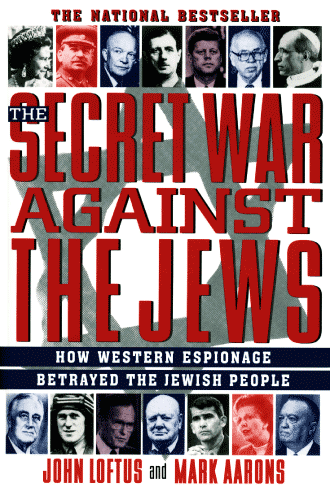
The authors demonstrate that numerous Western countries, especially the United States and Great Britain, have conducted repeated and wilful spying missions on Palestine and later Israel over many decades. While on the surface these two countries and others profess to be ardent allies of Israel, they work, in fact through their intelligence services to betray Israel's secrets to the Arabs. Their motive: oil and multinational profits, which must be attained at any price through international covert policies.
According to one of the authors' anonymous sources, former CIA director Allen Dulles was "one of the worst traitors in American history" because of his involvement in the linkage among Nazi corporations, U.S. oil interests and Saudi Arabia in the 1930s. The allegations are synthesized from interviews with some 500 former intelligence officers of various nationalities. The major powers, the authors argue, have repeatedly taken covert action designed to bring about the destruction of Israel, as much out of greed for oil as anti-Semitism. Among the charges made in these pages: Allied leaders conspired to block the creation of the State of Israel in 1948 for fear its presence would threaten the flow of Arab oil to the West. Great Britain and the United States, while pretending to support Israel during the Six-Day War, passed Israeli military secrets to their Arab foes. The Reagan administration tried to set up Israel as the principal scapegoat for the Iran-Contra scandal. Over the past 50 years, virtually every Jew in the world has been the subject of electronic surveillance by the British with the assistance of American intelligence. Loftus and Aarons wrote The Unholy Trinity.
"Europe, abetted by the United States and other nations, continues the ancient war against Jews in ways which are vividly narrated in this extraordinary book. This is the sort of story which must be brought into open view if ever we are to be wise enough to end the reflex hostility between Gentile, Arab, and Jew." – Thomas Keneally, author of Schindler's List
- Log in to post comments
